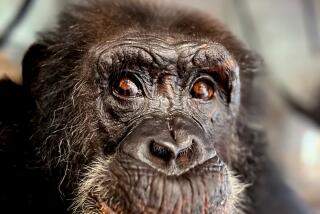Human Traits : Man, Ape: Blurring the Line
In the hills surrounding Lake Tanganyika in central Africa, the violence and death began with a surprise raid. Among the many political struggles of Africa, this conflict in the mid-1970s did not make the news. But in the world of science, its repercussions are still being felt.
The conflict was remarkable because the raiders and their victims were all chimpanzees. They were, in fact, inhabitants of the famous Gombe colony, which had been studied for more than 10 years by primatologist Jane Goodall. Up to that point, Goodall and her colleagues believed that chimpanzees led largely peaceable lives, and some scientists had speculated that manâs closest relative might even have some lessons to teach humankind about avoiding murderous aggression.
Separate Territories
The raids in Gombe changed all that. Within the Gombe range, four different communities of chimps coexisted, maintaining separate territories. Overall, relations among the groups appeared harmonious. Then, suddenly and unexpectedly, the chimpanzees from an area known as Kasakela Valley sent a patrol into a neighborsâ territory.
Followed by one of Goodallâs observers, the patrol moved quickly and silently into foreign ground. The silence alone was unusual for chimpanzees, which normally punctuate the air with elaborate chatter. At one point the group stopped in the dense forest and--again in silence--listened intently until they heard the hoots and calls from the other colony. Then they set out again, this time directly toward the sounds.
Lone Male Attacked
Soon the raiders burst upon a lone male from the other colony, a chimpanzee known to the researchers as Godi. Sensing the danger, Godi tried to flee, but it was too late. Three members of the patrol gave chase and a large male named Humphrey grabbed Godi by the leg and pulled him to the ground. Soon Humphrey had his foe pinned, sitting on Godiâs head while holding both legs.
The other members of the patrol then beat Godi to death. Some jumped on his back; others pummeled him with their fists. One chimp, named Hugo, inflicted deep slashing wounds with his teeth. In 10 minutes it was over.
Now screaming defiantly, the patrol members backed off from their victim and made triumphant displays around his prostrate body. The hoots and screams reverberated through the forest for many minutes until the chimpanzees finally quieted and headed home.
Over the next few months the patrols from Kasakela Valley attacked again and again. Some intended victims survived initial battles, only to be tracked down by subsequent patrols and killed. When it was over, all the males from the neighboring colony, known as the Kahama community, had been annihilated. The breeding females were taken over by the males from Kasakela and the territory appropriated. The Kahama community ceased to exist.
The destruction of the Kahama community represents the first time that scientists ever witnessed organized aggression being carried out by one group of non-human primates against another. As such it has become a milestone of sorts in a rapidly changing view of the primate world. In this new view, the distinction between man and other primates has become increasingly blurred, with scientists concluding that the great apes share many more human characteristics--both good and bad--than once thought possible.
Become the Norm
Indeed, interpretations of primate behavior that once would have been labeled anthropomorphism--the tendency to project human characteristics onto animals--have become the norm at the highest levels of scientific research. Over the last several years primatologists have published articles on subjects ranging from political coalitions among baboons to the development of tools by chimpanzees and the use of deception and psychological tricks among a variety of primates.
âTen years ago it was not acceptable to write that a chimpanzee had a purpose or intention for his behavior,â said Franz de Waal, a primatologist and author of a recent volume titled âChimpanzee Politics.â âNow we know that they do have intentions and they can think ahead in the sense of plotting a strategy. A lot of taboos have fallen away.â
Donna Haraway, a UC Santa Cruz professor who recently completed a study of primate research, said the transformation is the result of a wealth of new data that has flowed from field researchers over the last decade. âMost of what is known about primates has been gathered since 1975,â she said. âThereâs a tremendous amount of material now and it has shown that they (primates) do things with each other that people used to agree they couldnât.â
Caution Urged
Mindful of ambitious claims about animal behavior that were often repudiated in the past, some primatologists have urged caution in interpreting the new material. In particular, a debate rages over the proper language to use in describing some primate events. âSome people have referred to the chimp aggression as âwar,â â Haraway said. âTo me, war means organized state violence and I think using that kind of terminology with chimps is just nuts.â
No one disputes, however, that the scientific assessment of the chimpanzee and its world was changed forever by the Gombe raids. Shortly after Goodall reported the extermination of the Kahama community, a Japanese primatologist observed a similar series of attacks at another site in central Africa. Goodall concluded, in her 1986 book on the Gombe colony, that both episodes were âprecursors to warfare.â
As evidence for this, she pointed to the chimpanzeesâ use of patrols, which place only part of the aggressor community at risk, and the relentless pattern of the attacks. Each patrol accomplished a single assault or killing, using brutal violence, and they continued until all the males of the targeted colony were dead.
But why did one community of chimps decide to exterminate another? A number of theories have been put forward, most of them focusing on a goal similar to that of human wars: increased territory. In winning the struggle with Kahama, the Kasakela community nearly doubled its range and available food resources.
âThe chimpanzee has clearly reached a stage where he stands at the very threshold of human achievement in destruction, cruelty, and planned intergroup conflict,â Goodall wrote. She speculated that only the lack of language prevented the chimpanzee from undertaking the elaborate planning necessary for true warfare.
Some researchers argue that the discovery of warlike behavior on the part of the chimpanzee is not surprising, given the other intellectual abilities that primates have revealed in recent years. Among the most intriguing of these is the use of deception or tricks.
Recently, two primatologists from Scotland compiled a list of several hundred incidents of primate behavior that could be classified as attempts to deceive. In one such incident, a female baboon that was particularly fond of meat approached a male that had just caught an antelope. The male did not want to share his meal so the female began to groom him until he relaxed and lay back under her attentions. As soon as his guard had dropped sufficiently, the female snatched the carcass and ran.
In another case, a primatologist recalled watching a male chimpanzee being threatened by another chimp. An involuntary expression of fear began to creep across the threatened chimpâs face, an expression that he apparently did not want to reveal to the challenger. Keeping his back turned, the chimp surreptitiously put his hands to his face and manipulated it into an expression of calm, much as a child will sometimes wipe a smile from his face with his hands. The fearful chimp then turned and revealed a face of apparent indifference to the rival.
Primate deceptions have created a stir among scientists because they appear to show an ability to think several steps ahead and develop strategy.
Equally impressive have been demonstrations that some primate cultures make extensive use of long-term friendships and political coalitions.
University of Michigan primatologist Barbara Smuts contends that some female baboons actually use friendship as a criterion in choosing their sexual partners. Recording the mating activity of a baboon colony in Kenya, Smuts found that males that had established a âfriendshipâ with females stood a much better chance of being accepted as sexual partners.
Baboon âFriendshipâ
And just what is entailed in a baboon friendship? Smuts defines it as a willingness on the part of two baboons to spend a lot of time together eating and traveling, or merely grooming each otherâs fur. While the bonds established by these practices often did lead to later mating, such was not always the case, Smuts found. Sometimes a male and female would go through life spending much time together without engaging in sex. They seemed to be just, well, friends.
Political coalitions are more complex and usually represent efforts by a group of males to dominate a colony through collective effort. In this way a chimpanzee or baboon that is clever can often rise to the top over rivals that are far stronger physically. According to primatologist De Waal, coalitions are formed very carefully in a chimpanzee colony, with each coalition member having to consider the repercussions.
âOnce I watched a male being courted by two other chimps who wanted to form coalitions with him,â De Waal said. âThey both groomed this male and showed him special favors. When the male eventually made his choice, it seemed perplexing at first. He picked the younger, less experienced of the two.
âThen I saw what the male was probably doing. The younger partner would be more dependent on him if they succeeded in taking over the colony, and he (the male being courted) would be left in the real leadership position. I believe the male was thinking two steps ahead.â
Animal Behavior
Initially, these abilities may seem little different from other, well-known examples of remarkable animal behavior. Ground-nesting birds often go into broken-wing displays when approached by a predator, a tactic that deceives the predator and lures it away from the nest. Ant colonies reveal levels of organization as intricate as a corporationâs, and dogs will perform a series of maneuvers in a laboratory to receive a biscuit reward.
The difference, primatologists say, lies in the ability of primates to use their tactics spontaneously, just as man does, to achieve a goal. The dogâs tricks are a product of grim repetition; the sage hen is acting on instinct. Both creatures will repeat their actions when the right conditions exist. But the chimpanzee will change its tactics according to its purpose.
While the principle of intentional behavior among primates is now widely accepted, some specific interpretations have produced a lively debate. When the two Scottish primatologists published their paper describing deceit and tricks among primates, no less than 26 other scientists submitted critiques of the article, some of them pointedly critical.
Referring to the authorsâ use of the term âmind readingâ to describe one apeâs ability to psych out a rival, psychologist Irwin S. Bernstein asked, âWill we soon be writing of animal telepathy?â
Melinda Novak, an animal behavior specialist at the University of Massachusetts, said she is also unsettled by some of the intellectual leaps made in the field today.
âFor a long time we operated under the scientific rule called the law of parsimony, which said that you always must use the simplest explanation available and should not infer some higher process,â Novak said. âNow the pendulum has swung the other way. When you characterize two baboons as having a âfriendship,â you say something about that relationship but you are also implying many things about baboons that may not be there.â
Novak and others emphasize that these arguments do not assail the basic discoveries over the last decade. The findings, they say, have been held to far higher standards of research than some past claims--such as the now-repudiated claim by scientist John Lilly that dolphins are more intelligent than humans--and are unlikely to crumble under close examination.
Care Taken
As evidence of the care taken with the newer experiments, they cite the most recent round of communication experiments. At the Yerkes Primate Research Center in Atlanta, chimps and scientists now communicate through computers with keyboards that are marked with symbols rather than letters of the alphabet. The symbols can be strung together to make simple sentences, allowing a form of âtalkâ while putting the researchers at a distance from their subjects. Such techniques eliminate the subtle cues that can be transmitted through body language, a principal fault of earlier experiments.
Some scientists say that the new scientific data is also revealing unexpected distinctions between the great apes. Gordon Gallup, a psychologist at the State University of New York in Albany, was the first scientist to establish that only chimpanzees and orangutans appear to be aware of themselves as individual creatures.
Gallup used a simple but ingenious experiment to make his findings. Smearing a red dye on the foreheads of chimps, he then positioned them in front of a mirror. The chimps, accustomed to seeing their normal image in a mirror, were startled by the dye and studied it intently. They knew the image in the mirror was their own, and they knew their appearance had been changed.
As obvious as this feat may seem to humans, most other primate species cannot manage it. Gorillas and baboons, for example, do not respond to the red dye because, Gallup says, they have never developed a self-awareness.
These findings were important, Gallup contends, because self-awareness is a necessary precursor to many forms of purposeful behavior. âIf you ask me, âCan a baboon practice deception on others?â I would have to say I doubt it because the baboon appears not to have self-awareness. I would guess that there is another explanation for baboon behavior that seems to be purposeful deception,â he said.
If the great apes are closer to man than once believed, do they have more to reveal about the earliest humans? Some scientists believe so, pointing out that many of those now studying the apes are anthropologists who scrutinize primate colonies much as they would a primitive tribe. Goodall, for example, believes that the aggressions of Gombe colony may eventually tell scientists much about manâs intractable attraction to warfare.
Evolutionary Tunnel
Even the enthusiastic supporters of the recent interpretations caution, however, that huge gaps will always exist between man and other primates. In some ways man and the apes will forever regard each other through opposite ends of a very long evolutionary tunnel.
De Waal described an episode that illustrates such limits. âI am very interested in laughing, and I believe that chimpanzees do have a genuine laugh,â he said. âThey will play with each other and take on a play face and make laughing sounds. But if you ask, âDo they have a sense of humor?â thatâs a different matter. I doubt they do.
âOnce I watched while a huge male charged into a group making aggressive displays, and then slipped and fell down. To me that is funny and when I saw it I laughed. But the other chimps watched the same scene and went back to their eating. They did not laugh.â
More to Read
Sign up for Essential California
The most important California stories and recommendations in your inbox every morning.
You may occasionally receive promotional content from the Los Angeles Times.










